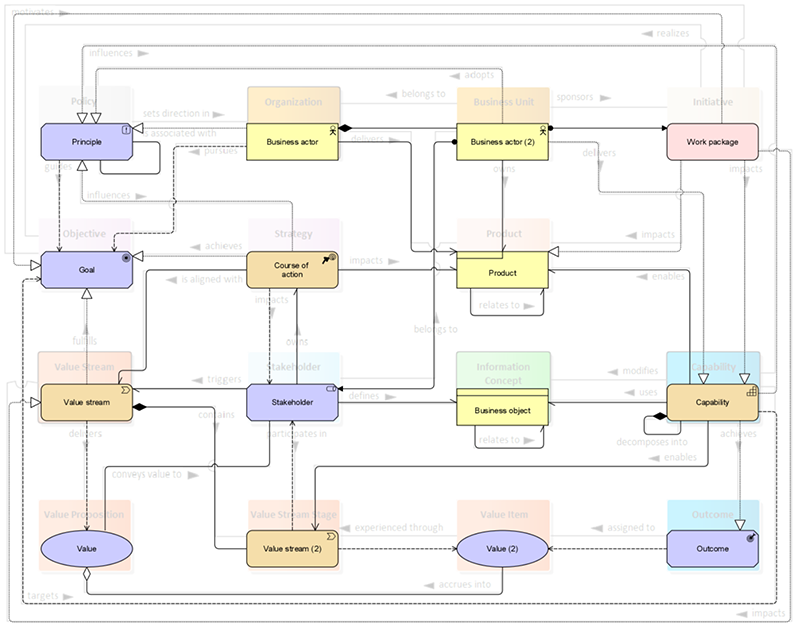Since the foundation of the Business Architecture Guild a little over a decade ago, its Business Architecture Body of Knowledge (BIZBOK®), as expressed in the BIZBOK® Guide, has become a popular set of guidelines and techniques for practicing business architects. More recently, it has also defined its metamodel, which you can read about in this whitepaper. This metamodel provides a core set of concepts for expressing business architecture in the sense that BIZBOK® defines it.
The ArchiMate® modeling language for enterprise architecture, first published in 2004 and established as an Open Group standard in 2009, also covers business architecture but has a wider scope. Moreover, it offers a notation as well as a metamodel, so you can write down your architecture models in a standardized way that your fellow architects understand.
Now, wouldn’t it be great if you could express BIZBOK®-based business architecture in ArchiMate? That would allow business architects to benefit from the well-established tool support for the language in expressing their business architecture artifacts. Moreover, it would let business architects easily connect these architectures to this broader and deeper scope of enterprise architecture.
The ArchiMate language was explicitly designed with such relations to other languages and metamodels in mind. It therefore provides a bridge to languages like UML and BPMN, with equivalent concepts. For instance, the ArchiMate ‘Application Component’ concept equates with the UML ‘Component’ concept.
Conversely, if we don’t link business architecture with the rest of enterprise architecture, it risks being a stand-alone discipline that cannot truly show value. Already, we see Business Architects sometimes struggle because ‘the business’ fails to understand their abstract concepts like ‘capability.’ By showing how those concepts are underpinned by more concrete elements like those mentioned above, they become much more tangible and understandable for non-architects.

We have created the mapping in the figure below to support this integration. The background shows the BIZBOK® metamodel, overlaid with applicable ArchiMate concepts and relationships. From the ArchiMate language, we use motivation, strategy, business, implementation, and migration elements.
The mapping between two conceptual universes is seldom 1:1. Some of the BIZBOK® concepts could be expressed with different ArchiMate elements. For example, the ‘Stakeholder’ concept in BIZBOK® can be used to express someone with an interest or concern, just like in ArchiMate. Still, it can also have an operational role, e.g., triggering a value stream. In ArchiMate, you can better express such operational roles using the ‘Business Role’ concept. Although there are a few different mapping options, the mapping above works well in practice and is a good starting point for your business architecture modeling efforts.
In this mapping, you may notice that ArchiMate uses a single concept at different hierarchy levels. For instance, the BIZBOK® ‘Organization’ and ‘Business Unit’ concepts are both expressed with an ArchiMate ‘Business Actor’ in the second mapping, one composed of the other. As you can imagine, an organization structure may have, e.g., Departments with Business Units, Teams within Departments, etc.
The same pattern is shown by BIZBOK’s ‘Value Proposition’ and ‘Value Item’, both mapped to ArchiMate’s ‘Value’ concept, and by ‘Value Stream’ and ‘Value Stream Stage’, both expressed as ‘Value Stream’ in ArchiMate. Moreover, unlike the more strictly defined BIZBOK® concept, you can even use an ArchiMate ‘Value Stream’ to model an entire value chain, thus linking your business architecture to your business model in the economic sense.
Such hierarchical levels occur in many other areas too, e.g. business process decomposition or application structure. For this reason, ArchiMate does not have any built-in, fixed hierarchies. Rather, it allows arbitrary composition and aggregation levels between elements of the same type. That flexibility provides you with yet another way to drill down from high-level, strategic views of the enterprise into progressively more detailed operational models. However, if you want to map the BIZBOK® concepts more closely to ArchiMate, you can use the language customization mechanisms outlined in Chap. 15 of the ArchiMate specification to create custom specializations for these different hierarchical levels. These could even have a custom notation.
From the concepts in this mapping, you can drill down into your enterprise’s operating model. More concrete concepts for that operational level can be linked with a Realization relationship to their more abstract counterparts in a business architecture model. For instance, ArchiMate Business Processes can realize a Value Stream stage, and Business Functions can realize a Capability. From this operating model, we can drill down deeper towards the implementation, for instance, to express that a Business Process is automated, modeling its realization by an Application Process performed by some Application Component.
That way, you can drill down from high-level business drivers and motivation via your business architecture into the underlying operating model as expressed in elements like business services and processes, applications, IT infrastructure, and physical technology. Such a line of sight provides essential business insights, helping you set investment priorities, analyze operational risks, assess regulatory compliance, foster innovation, and much more.
As you can see from the above, the ArchiMate language is an excellent way to express your BIZBOK® business architectures and relate them to other architecture and design domains. See also our eBook on Capability-based Planning for this. Of course, excellent tool support for modeling, analysis, and collaboration is vital. That way, business architecture truly becomes an actionable discipline!
Managing Consultant at Bizzdesign
Bernd has held various roles during career, including consultant, trainer, and global solutions manager. His expertise includes Business Architecture, Enterprise Architecture, Portfolio Management, and Business Intelligence, where he has guided customers in maximizing value from Bizzdesign Horizzon predominantly in finance and manufacturing sectors in DACH and EMEA region.
Managing Consultant & Chief Technology Evangelist at Bizzdesign
Marc contributes to Bizzdesign’s vision, market development, consulting, and coaching on digital business design and enterprise architecture. He also spreads the word on the Open Group’s ArchiMate® standard for enterprise architecture modeling, of which he has been managing the development. His expertise and interests range from enterprise and IT architecture to business process management.